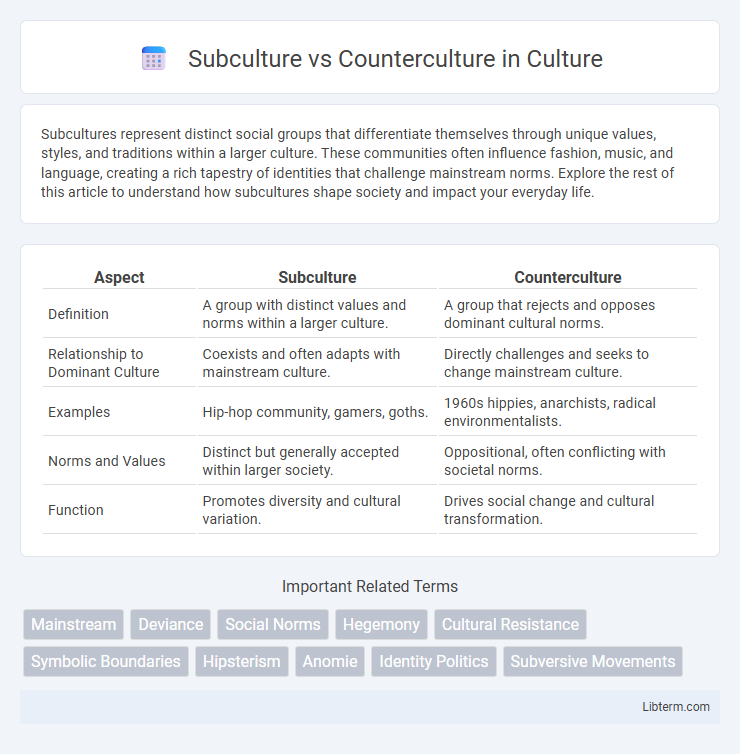Subcultures represent distinct social groups that differentiate themselves through unique values, styles, and traditions within a larger culture. These communities often influence fashion, music, and language, creating a rich tapestry of identities that challenge mainstream norms. Explore the rest of this article to understand how subcultures shape society and impact your everyday life.
Table of Comparison
| Aspect | Subculture | Counterculture |
|---|---|---|
| Definition | A group with distinct values and norms within a larger culture. | A group that rejects and opposes dominant cultural norms. |
| Relationship to Dominant Culture | Coexists and often adapts with mainstream culture. | Directly challenges and seeks to change mainstream culture. |
| Examples | Hip-hop community, gamers, goths. | 1960s hippies, anarchists, radical environmentalists. |
| Norms and Values | Distinct but generally accepted within larger society. | Oppositional, often conflicting with societal norms. |
| Function | Promotes diversity and cultural variation. | Drives social change and cultural transformation. |
Defining Subculture: Core Characteristics
Subculture is defined by a distinct set of beliefs, values, norms, and practices that differentiate a group from the dominant culture while coexisting within broader society. Core characteristics include unique language, style, rituals, and social behaviors that reinforce group identity and foster a sense of belonging among members. Subcultures often emerge around shared interests, such as music genres, fashion trends, or hobbies, without necessarily opposing mainstream cultural norms.
Understanding Counterculture: Key Traits
Counterculture is defined by its active opposition to dominant societal norms and values, often seeking radical change through alternative lifestyles or political activism. Key traits include a strong sense of collective identity, rejection of mainstream culture, and the promotion of social or political ideologies that challenge the status quo. Examples like the 1960s hippie movement illustrate how countercultures foster distinctive beliefs, behaviors, and symbols that profoundly impact cultural evolution.
Historical Origins of Subcultures
Subcultures originated during the early 20th century as distinct social groups that developed unique styles, values, and norms within larger mainstream cultures, often as a response to rapid urbanization and industrialization. These groups, such as the flappers of the 1920s or the beat generation of the 1950s, served as a way for marginalized youth to express identity and resistance without fully rejecting societal norms. Academic studies by sociologists like Albert Cohen and Dick Hebdige highlight how subcultures provide a symbolic framework for negotiating cultural meanings within dominant societies.
Counterculture Movements Through Time
Counterculture movements, such as the 1960s hippie movement and the Beat Generation of the 1950s, actively reject mainstream societal norms by promoting alternative lifestyles, values, and ideologies. These movements often arise during periods of social upheaval, challenging political structures, cultural conventions, and economic systems to advocate for civil rights, environmentalism, and anti-war sentiments. Historical examples include the Civil Rights Movement, the punk subculture of the 1970s, and contemporary digital activist groups that leverage social media to confront established power dynamics.
Subculture vs Counterculture: Main Differences
Subcultures are groups that share distinct values and behaviors within a larger culture without directly opposing mainstream norms, often influencing fashion, music, or language. Countercultures actively reject and challenge dominant societal values and norms, seeking to create alternative lifestyles or social orders. The main difference lies in their relationship to the mainstream: subcultures coexist and adapt, while countercultures confront and resist prevailing cultural standards.
Social Impacts of Subcultures
Subcultures contribute to social diversity by providing spaces where individuals share distinct values, styles, and interests that differ from mainstream culture, fostering identity formation and community belonging. These groups can challenge societal norms subtly by promoting alternative lifestyles and viewpoints, influencing fashion, language, and cultural trends on a broader scale. While subcultures often coexist peacefully within society, their presence can lead to increased tolerance and cultural exchange, enriching the social fabric.
Counterculture’s Influence on Society
Counterculture movements challenge prevailing social norms by promoting alternative values, lifestyles, and political views that often foster significant cultural and social change. Historical examples such as the 1960s hippie movement and civil rights activism highlight how countercultures can influence mainstream attitudes toward issues like peace, equality, and environmentalism. These transformative impacts reshape societal narratives, drive legislative reforms, and inspire ongoing dialogues about identity, freedom, and justice.
Examples of Famous Subcultures
Famous subcultures include the punk movement, characterized by distinctive music, fashion, and anti-establishment attitudes, and the goth subculture, known for its dark aesthetic and appreciation of gothic rock. The hip-hop subculture, originating from urban communities, emphasizes rap music, breakdancing, and street art as key elements. Skateboarding culture also represents a prominent subculture, blending sport, fashion, and music to create a unique lifestyle and identity.
Notable Counterculture Movements
Notable counterculture movements include the 1960s Hippie movement, which rejected mainstream values through psychedelic music, communal living, and anti-war protests. The Beat Generation challenged post-war American conformity with experimental literature and alternative lifestyles. Punk rock emerged in the 1970s as a counterculture movement promoting anti-establishment views, DIY ethics, and distinctive fashion.
Subculture and Counterculture in Contemporary Society
Subcultures in contemporary society consist of groups that share distinct styles, behaviors, and values within the broader culture, often influencing fashion, music, and social norms without opposing mainstream values. Countercultures actively reject and challenge dominant societal norms, seeking transformative social change through alternative lifestyles and political activism. Both subcultures and countercultures significantly contribute to cultural diversity, reflecting evolving identities and resistance in modern urban environments.
Subculture Infographic

 libterm.com
libterm.com